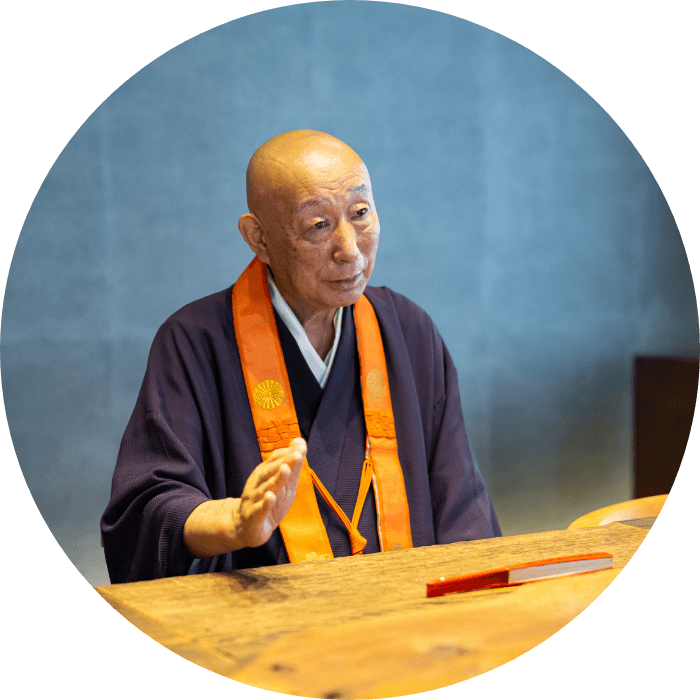Delving into Ninnaji Temple’s Past and Future with Head Priest Taishu Segawa
For centuries, Kyoto’s Ninnaji Temple has been a hub for art and culture. The temple’s head priest Taishu Segawa talks about what makes the temple so special and its initiatives to preserve its treasures and traditions for years to come.
-
Taishu Segawa
Head priest of Ninnaji Temple
Taishu Segawa is the 51st head priest of Ninnaji Temple, a UNESCO World Heritage site located in Kyoto. The temple was founded over a millennium ago and has strong ties with Japan’s imperial family.
Tell us about Buddhism in Japan and the history of Ninnaji Temple.
Buddhism arrived in Japan around the 6th century, and since then, it has had an enormous influence on the traditions and culture of Japan. It has helped shape the indigenous Shinto faith, which focuses on nature worship, and played an important role in the evolution of Japanese art, such as sculpture, scroll paintings, and calligraphy. Even cultural elements like tea ceremony and martial arts have roots in Buddhist thought. There are several schools of Buddhism in Japan, and Zen is probably the most well known abroad. You will find Buddhist temples all around the country that welcome people from all walks of life, regardless of their faith or background. Ninnaji is one among the 70,000 or so temples in Japan.
Ninnaji is a monzeki temple, which means that it is a temple with strong ties with the imperial family. It was completed by Emperor Uda in 888, who later became the first aristocratic priest in Japan. Since then, for a span of about a millennium, each successive head priest was of imperial lineage. The temple was destroyed in 1467 during the Onin War, and later rebuilt in the 17th century. Many of the surviving structures in the temple grounds are from that era—for example, our current Kondo (Main) Hall was actually relocated from the Kyoto Imperial Palace during the reconstruction period. It exemplifies imperial architecture, with intricate wood and lacquer work and beautiful latticed panels that disperse and diffuse light. These buildings are pieces of living history that give you a glimpse into age-old Japanese architectural techniques.

Kondo Hall, a National Treasure
Throughout the years, there was a strong desire to make Ninnaji a center for art and culture. We supported and nurtured many renowned cultural figures and artisans. For this reason, it has accumulated many precious artifacts, such as statues and scrolls. Several of them are designated National Treasures and Important Cultural Properties. So, for over a millennium, Ninnaji has embodied a mix of imperial culture, Kyoto traditions, and age-old craftsmanship. We hope to continue to keep these rich traditions alive, which is why we have decided to take on various initiatives to showcase and pass on our legacy to future generations.

Buddhist statues designated as National Treasures
What kind of initiatives have you been involved in?
The temple precinct is enormous and many of the buildings in the premises were sitting unused. It was a shame, as most of them showcase brilliant architectural techniques and traditional craftsmanship. We wanted to put these precious historical properties to use—they could serve as a bridge to connect with people on a deeper level.
We collaborated with the Iroha Nihon project to offer overnight stays at the temple ground, as a fresh new way of experiencing and immersing yourself in tradition. Guests stay in a renovated ancient villa called Shorin-an, and get the opportunity to explore the complex after the gates are closed to visitors. Monks guide you to parts of the temple that are usually off-limits to the public, giving you the chance to leisurely examine our many treasures. In the imperial ceremonial room, you are served shojin-ryori—Buddhist vegetarian cuisine—or a traditional Kyoto kaiseki course. Meditation, tea ceremony, and flower arrangement are among the experiences you can partake in. To most people, temples and their treasures may seem far removed from daily life, things to observe from a distance. This stay offers a rare and valuable chance to fully interact with Ninnaji’s rich cultural heritage.

Shorin-an villa

Traidtional court performance and ikebana flower arrangement
Cuisine is an important element of Japanese culture. We collaborate with renowned chefs to give talks on their philosophy and techniques, alongside meals and tea pairings. These events are designed to foster a deeper understanding and appreciation of the wonderful craftsmanship that underlies culinary arts.
We also offer free admission to high school students and under, so that the next generation has a chance to familiarize themselves with our history and tradition. In the past, temples and imperial customs may have seemed like something beyond the reach of the public. We are taking steps to make them more accessible and familiar, so that our culture keeps flourishing for centuries to come. I also think that by looking at the traditions of the past, we can generate innovations for the future.
What is the best time to visit Ninnaji Temple?
Ninnaji Temple is known for its late-blooming cherry blossom trees, known as Omuro Sakura. They bloom around mid-April, towards the end of Kyoto’s cherry blossom season. The trees are shorter than other varieties, so you can observe the flowers at eye-level. Looking carefully at cherry blossoms can be a meditative experience—their beautiful colors and patterns are a reminder of the miracle and transience of life.
The lush natural beauty of the temple garden comes out in full force during autumn, when the leaves change color—the maple leaves turn a brilliant shade of red. In summer, it’s wonderful to take a stroll in the evening when the temple is lit up. The area is picturesque throughout the year and accentuates the passing of the seasons.

Omuro cherry blossoms in bloom
Ninnaji Temple is located in Kyoto. What makes Kyoto unique?
Kyoto is an imperial town with a long history. Culture and craftsmanship flourished here over the years, and it still retains a subtle grace and beauty. The temples of Kyoto, including Ninnaji, play an important role in reminding us of the rich traditions that have been passed from generation to generation.
Observing precious cultural treasures and flowers in bloom, experiencing culinary traditions, and immersing ourselves in history can fill us with a sense of wonder about the past and help us foster a brighter future. I hope that people come here to experience these valuable legacies for themselves.

Fall colors
Recommended article
-

-
Tradition & Heritage
Learn More










